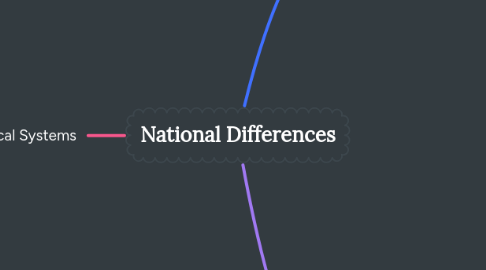
1. Political Systems
1.1. Collectivism and Individualism
1.1.1. Collectivism: A political system that emphasizes the primacy of common goals rather than individual goals
1.1.2. Socialism: Political philosophy that advocates public participation through state ownership through production and distribution
1.1.2.1. In current society, collectivists are socialists
1.1.3. Individualism
1.1.3.1. Emphasizes that an individual must be free to pursue his or her economic and political views
1.1.3.2. Built on two central principles
1.1.3.2.1. Focuses on the importance of ensuring individual freedom and self-expression
1.1.3.2.2. Social welfare is best served through allowing people to pursue economic selfinterest.
1.1.3.3. Message
1.1.3.3.1. The economic freedom and political freedom of the individual are the fundamental principles on which society is based
1.2. Democracy and Dictatorship
1.2.1. Democracy
1.2.1.1. A political system in which the government is chosen by the people directly or through their electedre presentatives
1.2.1.2. Representative democracy: A political system inwhich people periodically electindividuals to represent them
1.2.2. Dictatorial
1.2.2.1. A form of Government in which one individual or political party controls all of people's lives andprevents opposition parties.
1.2.2.2. Characteristic
1.2.2.2.1. Political repression is very common
1.2.2.2.2. Lack of fair elections
1.2.2.2.3. Information is strictly censored
1.2.2.2.4. Basic personal freedoms are limited
1.2.2.2.5. Challenging the authorities is prohibited
1.2.2.3. Forms of dictatorship
1.2.2.3.1. Communist dictatorship
1.2.2.3.2. Communist dictatorship
1.2.2.3.3. Tribal dictatorship
1.2.2.3.4. Right-wing dictatorship
2. Legal Systems
2.1. Differences in legal systems
2.1.1. Common Law: based on traditions, precedents, customs (England,America...)
2.1.2. Civil Law: based on a set of detailed laws established into rules (Germany,France, Japan, Russia...)
2.1.3. Theocratic law: based on religious teachings (Typically Islamic law)
2.2. Differences in contract law
2.2.1. According to common law: very detailed, every random event is clearly explained
2.2.1.1. Drafting costs are high but come with the advantage of high flexibility
2.2.2. According to civil law: brief, less detailed
2.2.3. United Nations Convention on the International Sale of Goods (CIGS)
2.2.3.1. establishes a general set of principles
2.2.3.1.1. governing the drafting and enforcement of ordinary commercial contracts
2.2.3.1.2. Countries that accept CIGS signal to other countries that they will use the treaty's principlesas part of their domestic law.
2.3. Property rights and corruption
2.3.1. Ownership
2.3.1.1. is a legal right to use an asset in return for any income related to that asset
2.3.1.2. Can be violated in 2 ways
2.3.1.2.1. Personal actions (stealing, copying, extortion...)
2.3.1.2.2. Acts of power: politicians and government officials seek income and resources fromowners (high taxes, expensive licensing requirements, etc.)
2.3.2. Corruption - a country with a high level of corruption will lead to:
2.3.2.1. Foreign direct investment decreased
2.3.2.2. international trade levels decline
2.3.2.3. the country's growth decreased
3. Economic Systems
3.1. Market economy
3.1.1. An economic system in which the interaction between supply anddemand determines the level of output of goods and services produced.
3.1.2. The role of government is to encourage free and fair competition among privateproducers.
3.2. Command economy
3.2.1. An economic system in which the government plans the goods and servicesthe country will produce as well as thequantities and prices for which those products and services will be sold.
3.2.2. Government-owned businesses have little incentive to develop to control costsand increase efficiency
3.2.3. Because of the abolition of private ownership, there is no longer anyincentive for individuals to find better ways to serve consumer needs.
3.2.4. Motivation and innovation will not appear
3.3. Mixed economy
3.3.1. A mixed economy includes some elements of a market economy andsome elements of a command economy.
3.3.2. Some economic sectors will be privately owned and subject to free marketmechanisms, others will essentially be State owned and planned by the government.
3.3.3. The government tends to nationalize companies that have problems but playan important role in national interests.
3.3.4. The number of countries with mixed economies is decreasing.
